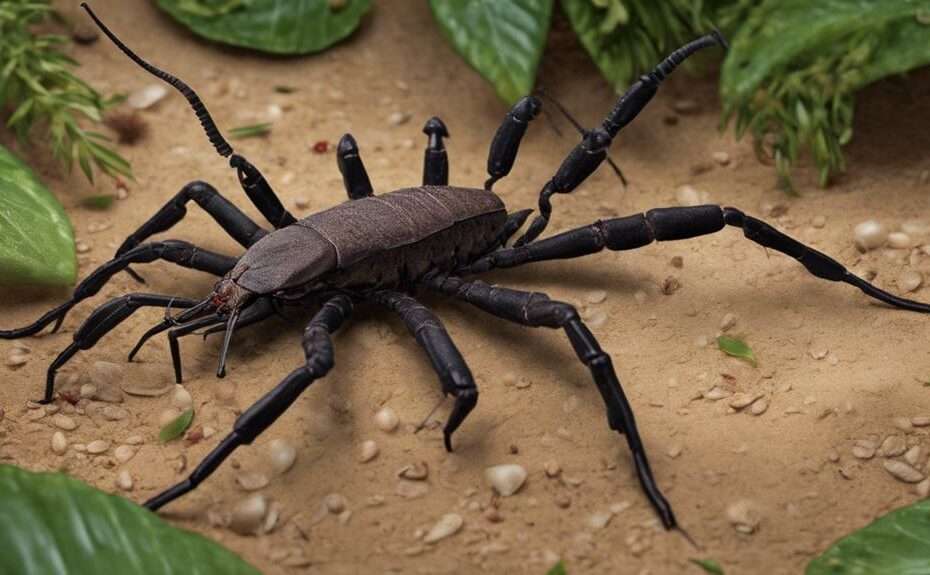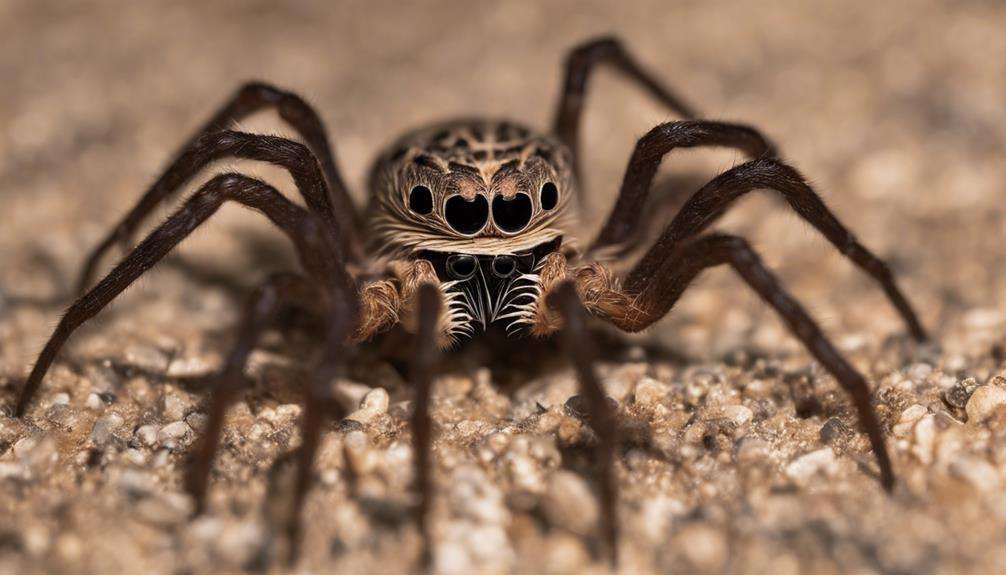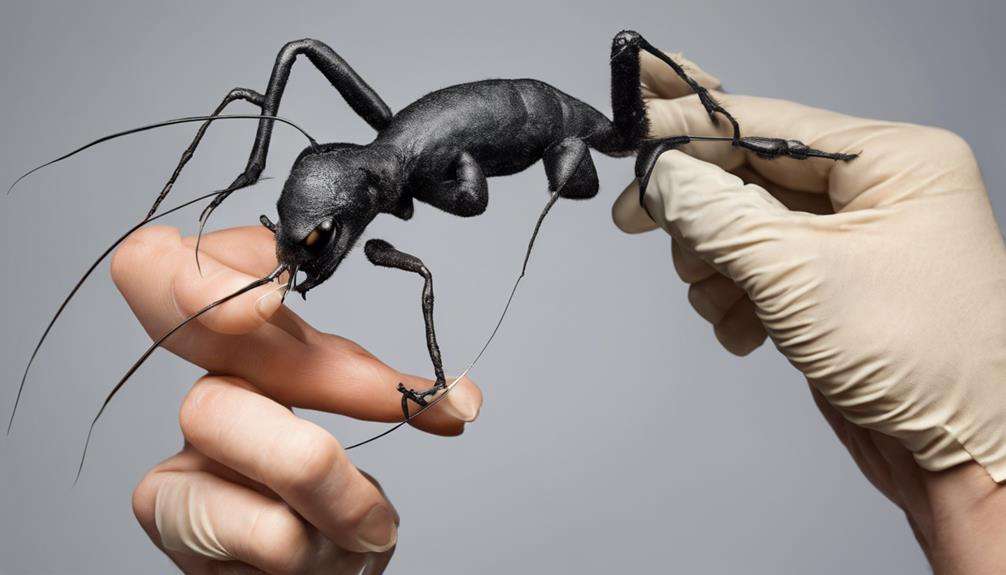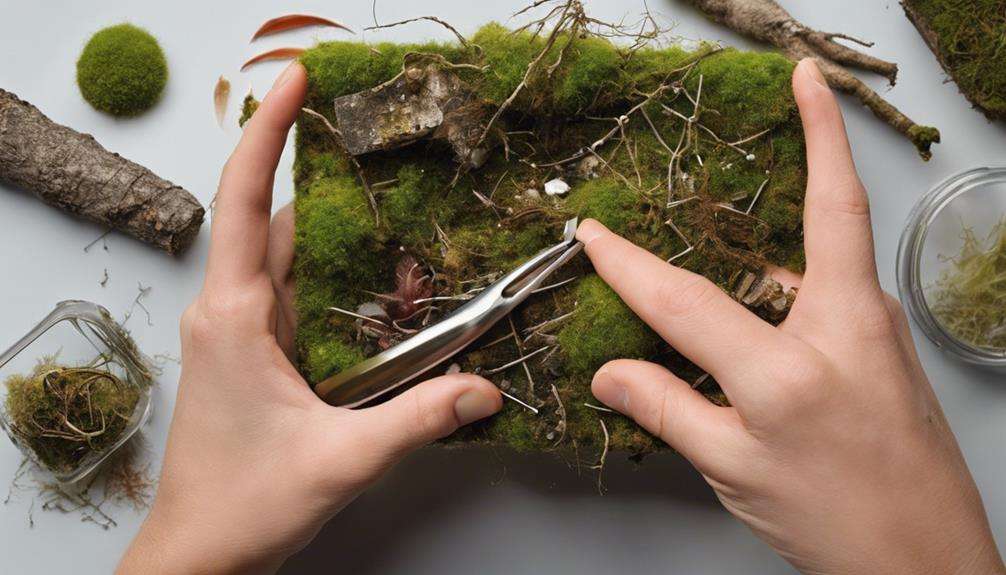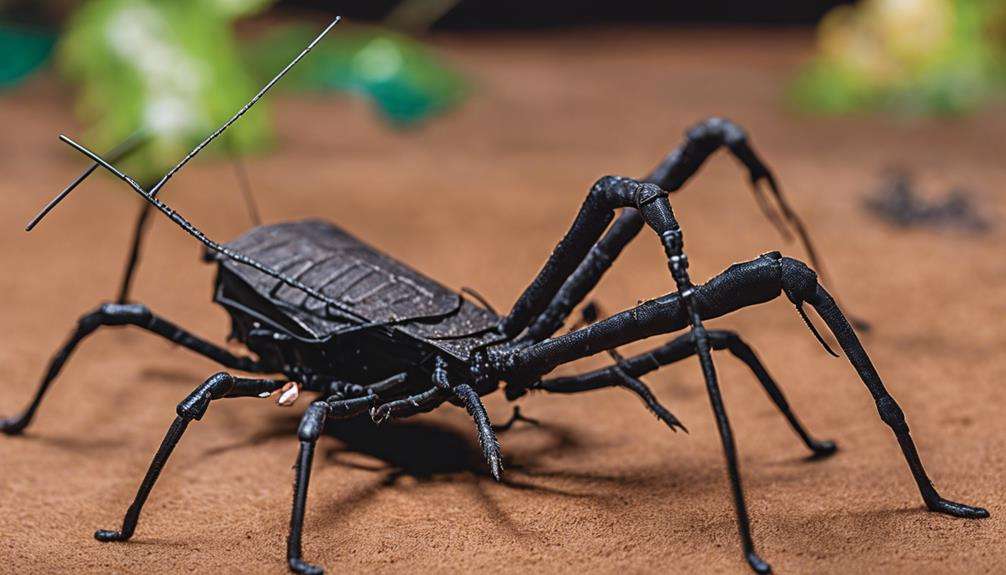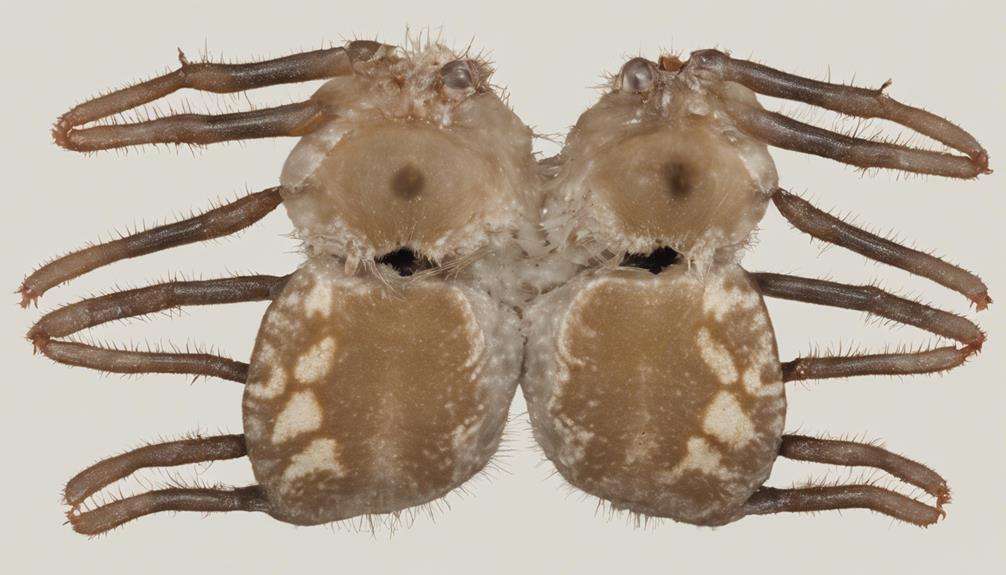You may think tailless whip scorpions have a mundane diet, but think again. These intriguing arachnids have a menu that might surprise you. From insects to juvenile lizards, their food choices are quite diverse.
Ever wondered how they catch their prey or what they drink? Well, their feeding habits are not just about survival; there's a fascinating strategy behind it all.
Stay tuned to uncover the secrets of these enigmatic creatures and their captivating culinary preferences.
Key Takeaways
- Tailless whip scorpions have a diverse diet, primarily insects, with occasional consumption of tiny vertebrates.
- They exhibit selective hunting techniques, favoring larger insects like beetles and moths.
- Specialized front legs and pedipalps aid in prey detection, capture, and feeding.
- Understanding their dietary preferences is crucial for conservation and captive care efforts.
Overview of Tailless Whip Scorpion Diet
The tailless whip scorpions exhibit a diverse diet primarily consisting of insects, particularly favoring larger prey items for sustenance. In the wild, they prey on a variety of insects such as beetles, crickets, and cockroaches. These scorpions are opportunistic feeders, occasionally consuming tiny vertebrates like juvenile lizards. Their diet also includes worms, frogs, and crustaceans, providing them with a varied food source that meets their nutritional needs.
Tailless whip scorpions drink water occasionally to stay hydrated, as moisture is essential for their survival. In captivity, zoos carefully adjust and control their diet to ensure they receive appropriate nutrition. This involves replicating their natural diet as closely as possible by providing a mix of live insects and other suitable prey items. By mimicking their natural feeding habits, zoos help maintain the health and well-being of these intriguing arachnids.
Natural Prey of Tailless Whip Scorpions
Tailless whip scorpions display a selective approach towards their prey, often opting for larger insects like beetles and moths. Their hunting strategy involves utilizing their slender front legs, which possess advanced sensory capabilities to detect and capture their prey effectively.
Understanding the natural prey preferences and hunting techniques of these arachnids contributes to a deeper insight into their ecological role and survival strategies.
Prey Selection
When observing the prey selection of tailless whip scorpions, one can note their preference for larger insects in their natural environment. These fascinating creatures show a diverse palate, not only preying on insects but also consuming larger bugs, juvenile lizards, worms, frogs, and crustaceans when available in their habitat.
Tailless whip scorpions have been observed to occasionally include tiny vertebrates like juvenile lizards in their diet. Additionally, to stay hydrated in their environment, these unique arachnids drink water occasionally.
This varied diet showcases the adaptability of tailless whip scorpions to different prey options, ensuring they meet their nutritional needs in the wild.
Hunting Techniques
Observing the hunting techniques of tailless whip scorpions reveals their remarkable use of slender, lengthy front legs with sophisticated sensory properties to locate and capture prey in their natural habitat. These front legs are equipped with specialized sensory hairs that help them detect vibrations and movement, aiding in pinpointing the location of potential prey.
Once prey is located, the tailless whip scorpions use their pedipalps near their mouths to grasp and grind up insects for consumption. Their unique leg structure allows them to feel for prey in their immediate surroundings, enhancing their hunting efficiency.
Being nocturnal hunters, tailless whip scorpions conduct most of their hunting activities at night, utilizing their keen senses and agile front legs to secure their next meal.
Unique Feeding Behaviors of Whip Scorpions
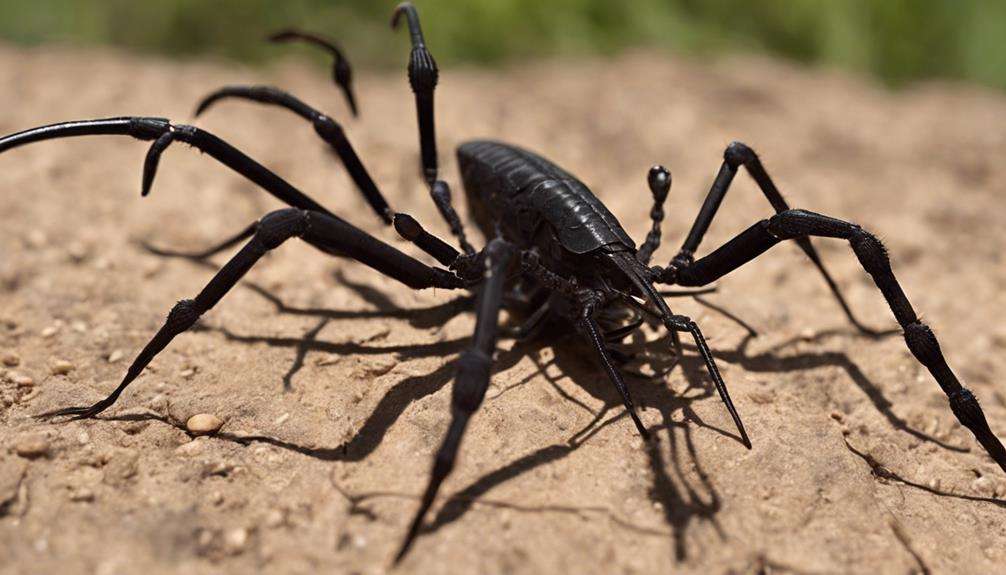
Feeding behaviors of whip scorpions exhibit a distinct pattern of prey selection and consumption, reflecting their specialized dietary preferences. When observing these intriguing creatures, you can notice the following unique feeding behaviors:
- Insect Predation: Whip scorpions primarily prey on insects, favoring larger options like crickets and cockroaches.
- Occasional Vertebrate Consumption: These scorpions occasionally consume tiny vertebrates such as juvenile lizards, worms, frogs, and crustaceans, diversifying their diet.
- Hydration Needs: Whip scorpions also drink water occasionally to stay hydrated, showing a holistic approach to their dietary habits.
- Zoo Diet: In captive settings like zoos, their diet mainly consists of insects, typically one to two per week, supplemented with occasional mealworms.
- Nutritional Control: Zoos ensure proper nutrition for captive tailless whip scorpions by adjusting and controlling their diet components, emphasizing the importance of a balanced diet for these fascinating arachnids.
Dietary Needs in Captivity
Tailless whip scorpions in captivity require a carefully controlled and adjusted diet to ensure proper nutrition and maintain their health. In captive settings, these creatures typically consume one to two insects per week. Mealworms are occasionally included in their diet to add variety and ensure a balanced nutritional intake.
Feeding routines for tailless whip scorpions are meticulously monitored and tailored to meet their specific dietary needs. Zoos, for instance, provide appropriate nutrition to ensure the well-being of these scorpions in captivity. By offering a diet consisting of insects like crickets, cockroaches, and mealworms, caretakers can ensure that captive tailless whip scorpions receive the necessary nutrients for their overall health.
Nutritional Requirements for Whip Scorpions
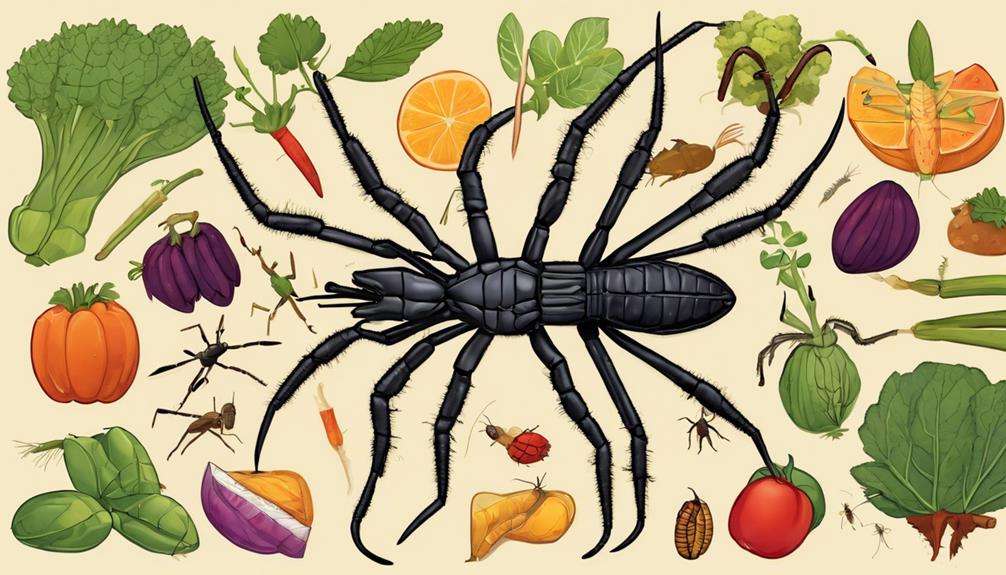
Tailless whip scorpions have specific nutritional requirements that are crucial for their health and well-being. Their diet must include a variety of insects rich in proteins and essential nutrients to meet their metabolic needs.
Understanding their feeding habits and essential nutrients can provide valuable insights into the optimal care of whip scorpions.
Whip Scorpions' Diet
In their natural habitat, tailless whip scorpions demonstrate a diverse diet consisting primarily of insects, with a notable inclination towards larger prey items. These fascinating creatures also consume tiny vertebrates like juvenile lizards, along with worms, frogs, and crustaceans. Their diet is occasionally supplemented by drinking water.
In zoos, the diet of captive tailless whip scorpions is carefully controlled and adjusted to ensure they receive appropriate nutrition. This varied diet enables whip scorpions to obtain the necessary nutrients for their survival and thriving in their environment. By preying on a range of creatures, tailless whip scorpions showcase their adaptability and predatory prowess.
Essential Nutrients Needed
A balanced diet rich in essential nutrients such as proteins, fats, vitamins, and minerals is crucial for the thriving health of whip scorpions. These arachnids rely on their insect prey to meet their nutritional requirements adequately.
Proteins are essential for growth and development, while fats provide energy and support various physiological functions. Vitamins play crucial roles in metabolic processes and overall health, ensuring proper functioning of the whip scorpion's body. Minerals like calcium and phosphorus are necessary for maintaining strong exoskeletons and internal structures.
In the wild, whip scorpions may also consume vertebrates like juvenile lizards, adding diversity to their diet and supplementing their nutrient intake. In captivity, their diet is carefully managed to ensure they receive a balanced nutritional profile through a variety of insect offerings.
Feeding Habits Analysis
Whip scorpions exhibit specific feeding habits that align with their unique nutritional requirements, showcasing a preference for larger insect prey items and occasional consumption of tiny vertebrates like juvenile lizards. Their feeding habits include:
- Mainly feeding on insects, with a preference for larger prey items.
- Occasional consumption of tiny vertebrates like juvenile lizards.
- Including worms, frogs, and crustaceans in their diet occasionally.
- Minimal but essential water intake, with occasional drinking observed.
- Zoos carefully adjusting and controlling the diet of captive tailless whip scorpions to ensure appropriate nutrition.
These feeding habits are crucial for tailless whip scorpions to meet their nutritional needs and maintain a balanced diet, both in the wild and in captivity.
Feeding Frequency for Pet Whip Scorpions
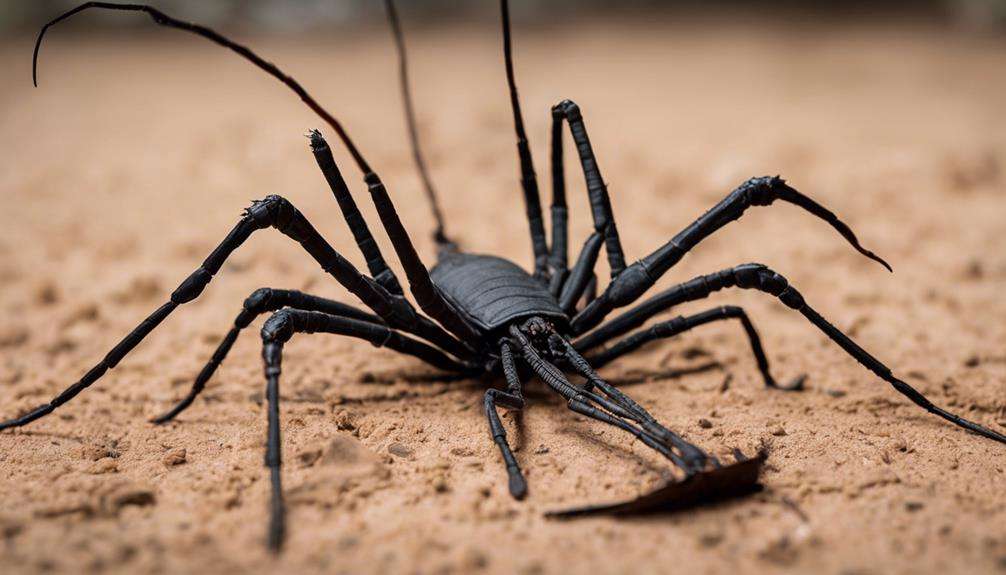
Feeding frequency for pet tailless whip scorpions in captivity is carefully adjusted to ensure optimal nutrition and health. These creatures typically consume insects such as crickets, mealworms, and roaches. In a captive setting, pet whip scorpions are usually fed one to two insects per week. This controlled feeding regimen allows for the monitoring of their nutritional intake and prevents overfeeding, which can lead to obesity and health issues. Mealworms are occasionally introduced into the diet of captive whip scorpions to provide variety and a balanced nutritional profile.
Zoos and experienced keepers meticulously supervise and regulate the feeding schedule of tailless whip scorpions in captivity. By offering a varied diet of insects in moderation, they aim to mimic the feeding patterns these creatures would experience in the wild. Providing adequate nutrition through a well-managed feeding routine is crucial for the overall well-being and longevity of pet whip scorpions.
Specialized Feeding Adaptations
Tailless whip scorpions exhibit remarkable specialized adaptations in their feeding anatomy, enhancing their efficiency in hunting and consuming prey. These adaptations include:
- Specialized Front Legs: Tailless whip scorpions have front legs with unique sensory properties that aid in hunting. These sensory properties help them detect vibrations and movements of potential prey in their environment.
- Pedipalps Usage: The pedipalps located near their mouth are essential for these creatures to grasp and grind up insects effectively before consumption. This grinding action helps in breaking down the prey into smaller, more manageable pieces.
- Tough Fangs and Jaws: Tailless whip scorpions possess robust fangs and jaws that assist in effectively consuming their prey. These structures enable them to pierce through the exoskeleton of insects and other small creatures.
- Unique Leg Structure: The leg structure of tailless whip scorpions is specially adapted to aid in hunting and capturing prey. Their agile and elongated legs help them navigate their surroundings and catch prey with precision.
- Antenniform Front Legs: Tailless whip scorpions use their antenniform front legs to feel for prey in their immediate vicinity. These specialized legs help them locate and assess potential food sources accurately.
Common Food Sources for Tailless Whip Scorpions
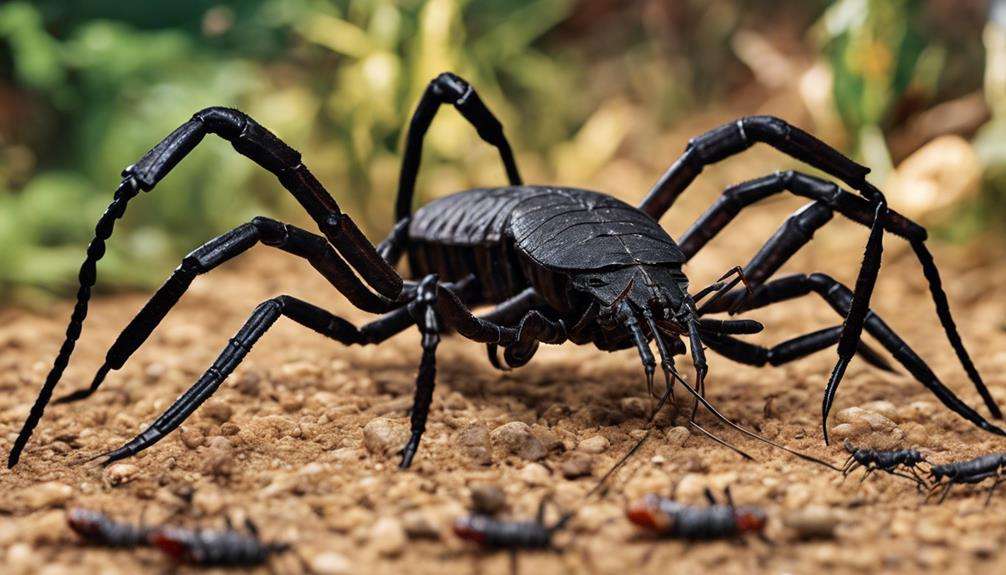
In their natural habitat, tailless whip scorpions commonly rely on a diet consisting of various insects like flies, crickets, cockroaches, and beetles. These arachnids exhibit a diverse palate, occasionally preying on small vertebrates such as juvenile lizards.
Apart from insects and lizards, tailless whip scorpions also incorporate worms, frogs, and crustaceans into their diet, showcasing their opportunistic feeding behavior. The consumption of a variety of prey items ensures that these creatures obtain essential nutrients vital for their survival and growth.
Tailless whip scorpions are known to drink water sporadically, fulfilling their hydration needs from available sources in their environment. Understanding the dietary preferences and sources of nutrition for tailless whip scorpions is crucial in conservation efforts and captive care to mimic their natural feeding habits accurately.
Observations in the Oakland Zoo provide valuable insights into the dietary habits of these intriguing arachnids.
Frequently Asked Questions
How Do Tailless Whip Scorpions Eat?
You eat like tailless whip scorpions, using your front legs to sense and capture prey. Your pedipalps grind insects for digestion. Strong fangs and jaws help break down food. You prefer larger insects and hunt by feeling.
What Are Some Interesting Facts About the Whip Scorpion?
Tailless whip scorpions possess unique anatomy, utilizing their antenniform legs for sensory perception. Their predatory behavior involves hunting at night with touch sensitivity. Environmental adaptations enable them to thrive nocturnally, showcasing intriguing reproductive cycles and defensive mechanisms.
How Long Can Tailless Whip Scorpions Go Without Eating?
You, as a curious observer, wonder how long tailless whip scorpions can go without eating. These creatures, with their slow metabolism and efficient energy storage, can survive for several weeks without food, but regular feeding is vital for their health.
How Often Do You Feed a Tailless Whip Scorpion?
You feed a tailless whip scorpion following a set feeding schedule to meet its nutritional requirements. These creatures have specific feeding habits, preferring larger insects as ideal prey items. Feeding them once or twice a week regulates their feeding frequency.
Conclusion
In conclusion, the diet of tailless whip scorpions is truly fascinating, as they've evolved to consume a variety of prey ranging from insects to small vertebrates.
Their unique feeding behaviors and specialized adaptations make them efficient hunters in their natural habitat.
It's no exaggeration to say that the diet of tailless whip scorpions is a marvel of nature, showcasing the incredible diversity and complexity of the animal kingdom.
